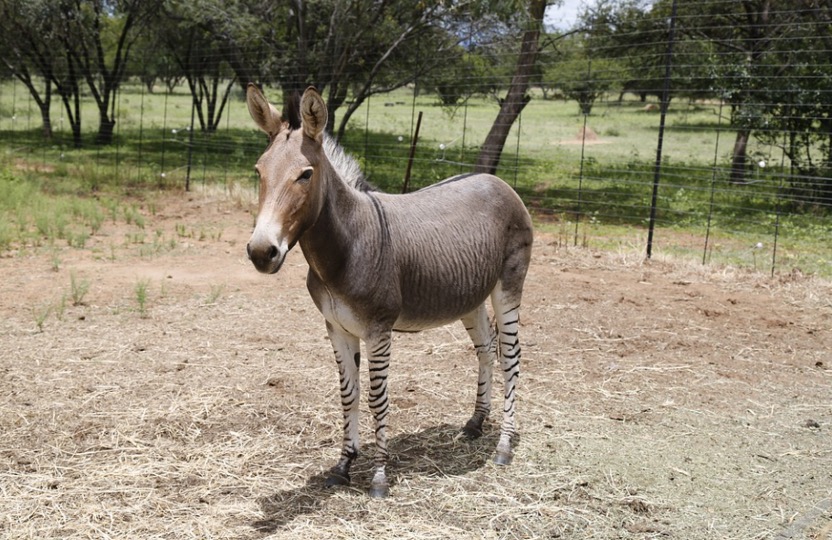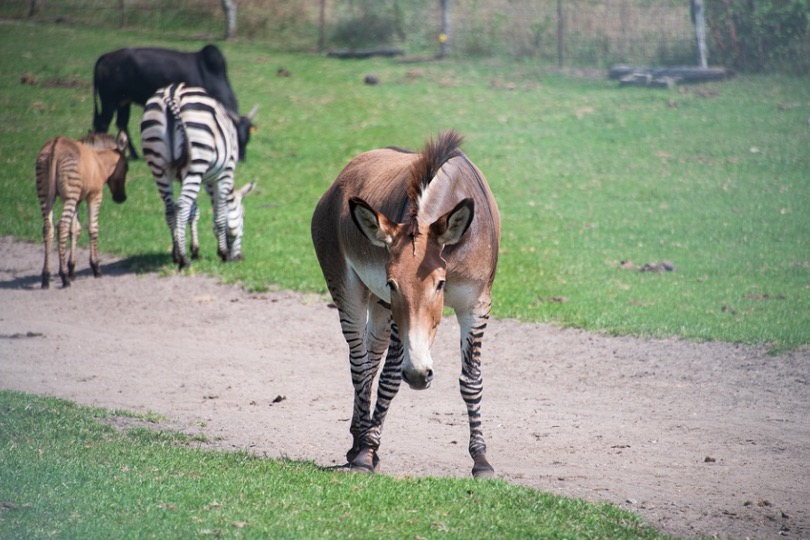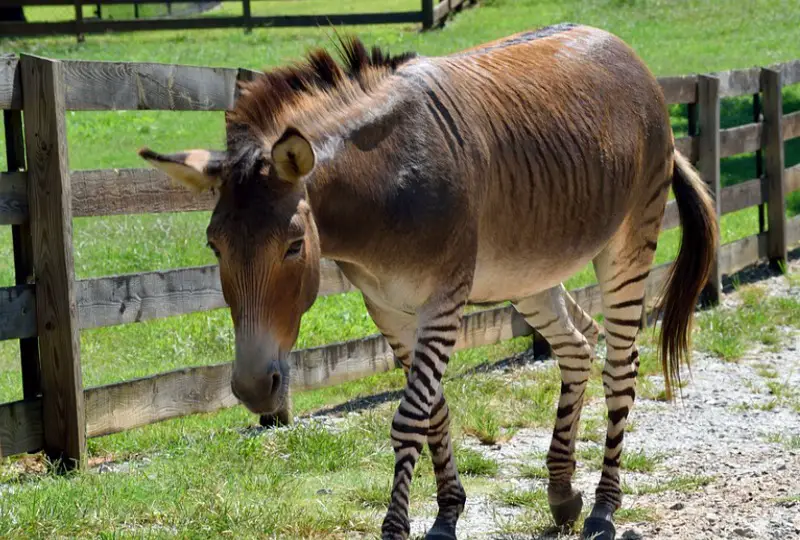Table of Contents
Zonkey: All You Need To Know
A Zonkey is a hybrid herbivore animal that belongs to the kingdom of Animalia, phylum Chordata, and class Mammalia. Its genus is Equus, and its species is E. zebra (Zebra) crossed with E. africanus asinus (Donkey).

Its length is up to 20 to 25 m, and it weighs about 80 to 450 kg. It lives in a domestic habitat, with a lifespan of up to 15 to 25 years.
What is Zonkey?
A “zonkey” is a cross between a zebra and a donkey that results from mating. Because they have an odd number of chromosomes and are unable to breed, zonkeys are not considered genuine species. Zonkeys are bred in a variety of zoos and specialist farms across the world, despite their rarity.
Depending on who is breeding them and what mix of donkey and zebra species is being utilised, zonkeys are also known as zebonkeys, zebrinny, zebrula, zebadonks, and a variety of other names. Zonkeys are extremely rare in nature and can only be found in zoos or on game-animal farms.

Zonkeys are one of several “zebroids” (zebras that have been crossed with other horse species). Because all Equus members are very similar, a variety of combinations are conceivable. Zebras have also been crossed with horses (zorse) and ponies in addition to the zonkey (zony).
Is It Possible For Zonkeys To Reproduce?
Although females can sometimes be viable, none of these “zebroids” produce fertile males. The ladies must be partnered with either a donkey or a zebra because none of the men are viable.
Because the children acquire the proper DNA from their father, they may be viable and fruitful – albeit genetically, this is a long shot. Plus, the genetic signature wouldn’t be half donkey and half zebra any longer. It’d have more of whatever animal was chosen as the father.
Interesting Facts About Zonkey
A hybrid animal like the zonkey is not only fascinating, but it also encompasses several essential biological principles!

Zonkey: a Hybrid
creating a hybrid While it may seem strange that two species may interbreed, it happens all the time in biology. A wide range of species have been used to generate hybrids. Here’s a rundown of some of the most well-known species crossbreeds:
1. Mule is a cross between a female horse and a male donkey.
2. Hinny is a female donkey crossed with a male horse.
3. Tulu Camel-Dromedary Camel X Bactrian Camel.
4. Spinner Dolphins versus Striped Dolphins–Clymene Dolphin.
5. Narluga – a cross between a Beluga Whale and a Narwhal.
6. Killer Bees – African Honey Bee X European Honey Bee.
7. Liger – a cross between a tiger and a lion.
And these are only a few of the creatures that may be hybridised. The list would be enormous if you included plants, fungus, and microbes. Most contemporary people are thought to be the product of early human hybridization with Neanderthals and other ancient hominids, according to evidence.
In essence, hybrids can develop into their own species if they inherit an equal number of chromosomes from closely related species (to assure meiosis success).
Because they are unable to reproduce effectively, many hybrids are not genuine species. Many horse hybrids, such as the zonkey, have an odd number of chromosomes, which causes major problems during meiosis. Because the proteins they encode have developed along such distinct evolutionary routes, animals that are entirely unrelated are highly unlikely to create a hybrid.
Sterile Hybrids (Haldane's Rule)
J.B.S. Haldane, an evolutionary scientist, discovered in 1922 that genetic hybrids are frequently inviable or sterile. He also pointed out that the heterogametic sex is more impacted in most hybrids than the homogametic sex.
Males are the heterogametic sex in animals because they have both an X and Y chromosome. Male zonkeys are alive, but they are infertile and unable to breed. This is why it is difficult to have two zonkeys reproduce — only the female can reproduce, and the majority are sterile.
The explanation for sterile hybrids is simple: a hybrid creature has an odd number of chromosomes. A zonkey is created by crossing a plains zebra (44 chromosomes) with a donkey (62 chromosomes). As a result, the child has 53 chromosomes. Meiosis does not produce balanced haploid cells since 53 divides unevenly.
Instead, they are frequently inviable cells that are incapable of reproducing. Males (the heterogametic sex) are generally infertile since their parents did not provide them with a complete complement of functioning chromosomes.
Equine Hybrids
Donkeys and zebras are only one of the many Equus genus hybrids that have been developed. Despite the fact that the genus’s species have different numbers of chromosomes, they have developed in remarkably similar ways.
Some speciation events, according to biologists, occur when a genomic mistake causes whole chromosomes to be replicated or duplicated by accident. Though zebras and donkeys have quite different appearances, they both express many of the same proteins.
Almost every other hybrid horse breed, including mules, hinnies, zorses, and zony breeds, is the same. While this might result in infertility, there are some advantages. Mules, for example, are considerably stronger, more heat-tolerant, and live far longer than horses. More study is needed to determine the advantages of producing a zonkey!
Zonkey Citations
- Tracking Five Millennia of Horse Management with Extensive Ancient Genome Time Series. Cell. 2019 May 30; 177(6): 1419–1435.e31.
- Phylogenetic Relationships of Turkish Indigenous Donkey Populations Determined by Mitochondrial DNA D-loop Region. Animals (Basel). 2020 Nov; 10(11): 1970.







